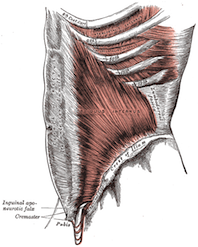Fascia: Difference between revisions
No edit summary |
No edit summary |
||
| Line 1: | Line 1: | ||
<div class="editorbox"> | <div class="editorbox"> | ||
'''Original Editor '''- | '''Original Editor '''- [[User:Laura Ritchie|Laura Ritchie]] | ||
'''Top Contributors''' - {{Special:Contributors/{{FULLPAGENAME}}}} | '''Top Contributors''' - {{Special:Contributors/{{FULLPAGENAME}}}} | ||
</div> | </div> | ||
== Introduction == | == Introduction == | ||
| Line 50: | Line 36: | ||
<references /> | <references /> | ||
[[Category:Anatomy | [[Category:Anatomy]] [[Category:Videos]] | ||
Revision as of 11:13, 14 October 2013
Original Editor - Laura Ritchie
Top Contributors - Esraa Mohamed Abdullzaher, Laura Ritchie, Sehriban Ozmen, Lucinda hampton, Andeela Hafeez, Stacy Schiurring, WikiSysop, Admin, Kim Jackson, Carin Hunter, Carina Therese Magtibay and Evan Thomas
Introduction[edit | edit source]
A fascia is a layer of fibrous tissue. A fascia is a structure of connective tissue that surrounds muscles, groups of muscles, blood vessels, and nerves, binding some structures together, while permitting others to slide smoothly over each other. Various kinds of fascia may be distinguished. They are classified according to their distinct layers, their functions and their anatomical location: superficial fascia, deep (or muscle) fascia, and visceral (or parietal) fascia. [1]
Like ligaments, aponeuroses, and tendons, fasciae are dense regular connective tissues, containing closely packed bundles of collagen fibers oriented in a wavy pattern parallel to the direction of pull. Fasciae are consequently flexible structures able to resist great unidirectional tension forces until the wavy pattern of fibers has been straightened out by the pulling force. These collagen fibers are produced by the fibroblasts located within the fascia. [1]
Fasciae are similar to ligaments and tendons as they are all made of collagen except that ligaments join one bone to another bone, tendons join muscle to bone and fasciae surround muscles or other structures. [1]
Management / Interventions[edit | edit source]
Resources[edit | edit source]
The following videos provide additional information regarding fascia and can be viewed on the YouTube channel "Integral Anatomy."
- Integral Anatomy, V1 pt1: Skin & Superficial Fascia
- Integral Anatomy V1 pt2: Skin and Superficial Fascia
- Integral Anatomy V2 pt1: Deep Fascia and Muscle
- Integral Anatomy, V2 pt2: Deep Fascia and Muscle
- Integral Anatomy V3 pt1: Cranial and Visceral Fasciae
- Integral Anatomy V3 pt2: Cranial and Visceral Fasciae
- Integral Anatomy V4 pt1: Viscera and their Fasciae
- Integral Anatomy V4 pt 2: Viscera and their Fasciae
References[edit | edit source]
- ↑ 1.0 1.1 1.2 Fascia. Wikipedia, the free encyclopedia. http://en.wikipedia.org/wiki/Fascia (last accessed 13 Oct 2013).







